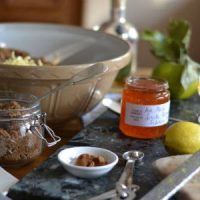
RECIPE INGREDIENT: Wild Garlic
Tried and tested seasonal ingredient notes from our country cookery school kitchen garden. As well as hacks and get ahead tips for EVERY cook who loves to be in the garden.
The arrival of spring brings wild garlic to our Dorset hedgerows and woodland. In years gone by folklore tells of this biannual plant warding off evil spirits. Nowadays, it is a welcome addition to the kitchen table.
In Season
Spring
Late March to Early May
Where To Forage
Chalk woodlands,
hedgerows & shady banks
Plant Family
Allium Ursinum
Native bulb related to chives, leeks & onions


How & When to Forage:
Tiny shoots begin to show as soon as the snowdrops fade. For personal use, foraging is allowed along hedgerows of permissive footpaths. Obviously avoid dog walking areas and seek the landowners permission to gather from woodlands. Take only what you need and only pick a few leaves from each plant. Then the plant can develop fully and will set seed for the following year.
How to store:
After foraging, wash in salted cold water, taking care not to damage the tender leaves. Pat dry and wrap in a clean tea towel to store in the fridge salad box for a couple of days.
Ideally use straight away. Preserve by making a flavoured butter for the freezer or an infused oil.
How to cook:
Wild garlic wilts quickly in a pan with a little butter, just like spinach. After frying, and whilst resting a steak or best end of lamb, add roughly torn leaves to pan juices. Wilt for a few moments, then add a little crème fraîche to finish. Serve alongside the meat.
Early shoots can be chopped and eaten raw like chives. Whilst established leaves will partner with other spring greens such as nettle tops and sorrel, for a vibrant garlic note.
Use the leaves:
- Roughly chop and cream with softened butter. Add generous grating of lemon zest, black pepper and a pinch of sea salt. Spread within a baguette to make wild garlic bread. Or add a generous knob to griddled steak, fish and roasted vegetables.
- Scatter a handful of leaves into a roasting tin. Carefully loosen the skin of a free range chicken. Smear the underside liberally with flavoured butter and rest on top of the wild garlic leaves to roast as normal. Serve with the infused meat juices.
- Blitz wild garlic leaves with ricotta, pine nuts and spinach to fill homemade pasta or stuff savoury pancakes.
- Tear leaves by hand then grind in a pestle and mortar along with grated Gouda and olive oil to prepare a pistou. Season to taste. Drizzle over a generous dish of pasta, fish soup or a salad or quinoa, pulses or rice.
- Partner with spinach, eggs and parmesan for a savoury roulade, fill with cream cheese and chopped walnuts before rolling.
- Add freshly chopped leaves to pastry for a seasonal quiche or tart. Alternatively, simply add a few torn leaves to the filling, before adding cream, eggs and seasoning.
Use the edible flowers:
- Later in the season, harvest the flowers to garnish salad bowls and griddled vegetables.
- Pinch out the individual flowers to decorate savoury nibbles or parmesan shortbread.
- Partner with slow roasted tomatoes and your favourite cheese for a spring first course.



Harvest the seeds:
Place the stem and seed heads on a cooling rack within a deep roasting tin. Dry slowly in the AGA simmering oven or in a conventional oven on the lowest setting. Allow the steam to escape by propping the door open with a wooden spoon.
Once the seeds are dry, remove the stems by running a fork through the seed head.
Combine with sea salt and pound in a pestle and mortar or blitz in a food processor to make wild garlic sea salt.
Store in a sterilised jar and use to season roast lamb, chargrilled steak, roasted vegetables and focaccia.
More about All Hallows' Farmhouse
Home to Lisa Osman’s award-winning AGA approved cookery school in Dorset. A unique place to learn, cook and stay. Shop our range of sustainable kitchen linens and iconic mixing bowls.







